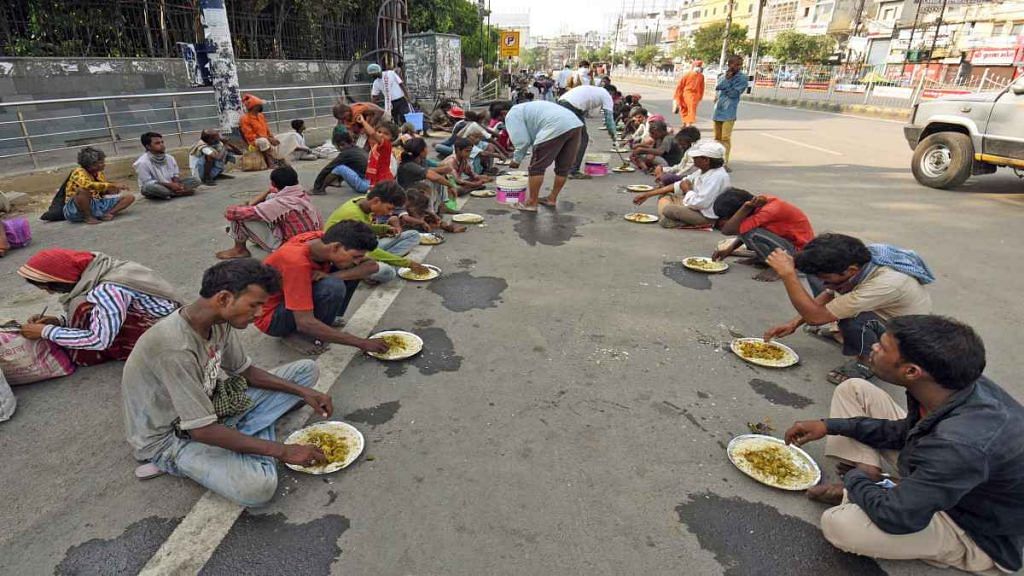New Delhi: Prime Minister Narendra Modi skipped mentioning a certain detail when he announced the extension of the PM Garib Kalyan Yojana (PMGKY), aimed at easing the impact of the Covid-19 lockdown on the poor, in his address to the nation Tuesday.
While the scheme will now allow free rations to the poor until November, states no longer have the right to decide what pulses to give out. The choice has now been standardised at chana or gram, from which the chana dal is derived.
In the first round of the PMGKY lockdown aid, from April-June, states could decide what pulses to distribute among beneficiaries of the scheme. Not anymore, because, according to the government, a host of factors come together to make chana the most convenient option.
“The chana dal was widely accepted by states when consulted for the next phase of the scheme,” Union Minister of Consumer Affairs, Food and Public Distribution Ram Vilas Paswan told ThePrint.
“Chana dal was also agreed upon because it does not require much milling and processing as compared to other pulses allocated previously. It can be soaked and cooked easily, unlike other pulses like moong, arhar, urad and masoor, which require 5-7 days of processing.”
Officials in the ministry said there were other factors too. Due to a bumper harvest in the ongoing rabi harvest season, chana is the only pulse available in the government’s buffer stock that can be uniformly distributed on the level envisaged by the scheme — 1 kg each for 19.66 households for five months.
At Rs 48.75/kg, it is also one of the cheapest in terms of procurement costs, which makes it best suited for the public distribution system (PDS) as the low price mitigates the risk of hoarding.
Also Read: Modi govt’s Garib Kalyan: Does India have the ability to deliver amid Covid-19 lockdown?
Food aid for the needy
The Modi government announced a massive food-aid effort under the PMGKY this March as the country went into a complete lockdown to address the Covid-19 pandemic. The lockdown has eased since last month, but the threat posed by the pandemic rules out a return to business-as-usual just yet.
This means that the scores of daily-wagers and labourers stripped of livelihood options by the lockdown will likely have to wait longer before they can find jobs that assure sustenance.
In this light, the Modi government extended the food aid under PMGKY this week, saying it will now be applicable until November. So far, the PMGKY assured each beneficiary 5 kg of free wheat/rice and each household a kg of pulses “according to regional preferences”.
As a result, many southern and northeastern states opted for pulses like moong, tur (arhar), urad and masoor from April-June. Among other states, only a handful like Uttar Pradesh and Jharkhand chose chana dal for all three months.
Now, however, everyone will have to settle for chana dal.
Also Read: I will do any job I find – How India’s desperately poor hope to get out of Covid misery
Why chana dal?
The decision to distribute chana alone is driven by practicality and availability, officials in the consumer affairs ministry said. On account of the distribution made in the first round of PMGKY, the central government was left with a low amount of pulses in its buffer stock. Meanwhile, there was a bumper harvest of chana.
As on 26 June, according to ministry data, the central buffer stock comprised 8.76 lakh metric tonnes (LMT) of pulses, out of which 3.77 LMT is arhar, 1.14 LMT is moong, 2.28 LMT is urad, 1.30 LMT is chana, and 0.27 LMT is masoor. To provide 1 kg of pulses per month, for five months, to 19.66 crore households, the central government needs 9.83 LMT of pulses.
“Chana, moong and masoor are the only three pulses that will be added to current buffer stock estimate as their rabi harvest is currently being procured at the minimum support prices,” said an official of the ministry. “Until 29 June, 20.4 LMT of chana dal had been procured for the buffer stock, and 3.4 LMT moong and 1.43 LMT masoor,” the official added.
“While the procurement of moong and masoor is almost over, chana dal will be procured in Madhya Pradesh where there has been a bumper harvest in regions like Sehore, Hoshangabad and Raisen. Therefore, the stock of chana will increase further to 30-35 LMT. Also, no other pulses other than these three will be harvested or procured in coming months so chana dal is the only option,” added the official.
Out of the total production of pulses in India, chana dal accounts for 45-50 per cent at 112.3 LMT a year, while tur makes up 16 per cent with a production of 42.5 LMT. These pulses comprise up to three-fourths of India’s consumption.
The food ministry official also pointed out that chana dal is cheaper than most other alternatives.
Arhar, which was the most sought-after pulse under the first batch, has a procurement cost of Rs 60/kg, whereas moong and masoor have a procurement price of Rs 71.96/kg and Rs 48/kg, respectively. Chana dal is the only pulse that is both in abundance and also cheap at Rs 48.75/kg.
“The choice of chana dal was also made because it is cheap compared to other pulses except for masoor. Even if the chana dal is leaked from the PDS under the PMGKY scheme, it will not lead to a price disruption or hoarding as the dal is already in abundance in local markets due to the ongoing harvest season.”
The uniform choice may also stem delays in arranging pulses, as experienced between April and June on account of the state’s different preferences.
Also Read: ‘New class of poor’ emerging after job losses in lockdown, 95.8% BPL slum families hit: Study
